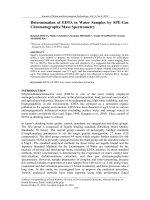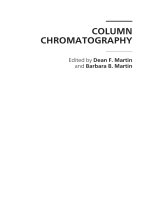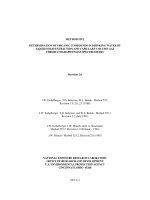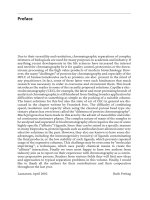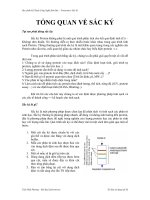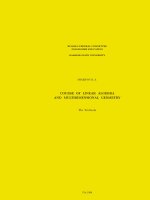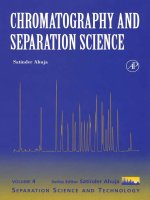multidimensional chromatography
Bạn đang xem bản rút gọn của tài liệu. Xem và tải ngay bản đầy đủ của tài liệu tại đây (4.44 MB, 444 trang )
Multidimensional Chromatography
Multidimensional Chromatography
Edited by Luigi Mondello, Alastair C. Lewis and Keith D. Bartle
Copyright © 2002 John Wiley & Sons Ltd
ISBNs: 0-471-98869-3 (Hardback); 0-470-84577-5 (Electronic)
Multidimensional
Chromatography
LUIGI MONDELLO
Dipartimento Farmaco-chimico, Università degli Studi di Messina, Italy
ALASTAIR C. LEWIS
School of Chemistry and School of the Environment, University of Leeds, UK
KEITH D. BARTLE
School of Chemistry, University of Leeds, UK
JOHN WILEY & SONS, LTD
Copyright © 2002 by John Wiley & Sons Ltd,
Baffins Lane, Chichester,
West Sussex PO19 1UD, England
National 01243 779777
International (+44) 1243 779777
e-mail (for orders and customer service enquiries):
Visit our Home Page on
All Rights Reserved. No part of this publication may be reproduced, stored in a retrieval system,
or transmitted, in any form or by any means, electronic, mechanical, photocopying, recording,
scanning or otherwise, except under the terms of the Copyright, Designs and Patents Act, 1988 or
under the terms of a licence issued by the Copyright Licensing Agency Ltd, 90 Tottenham Court
Road, London, UK W1P 0LP, without the permission in writing of the Publisher.
Other Wiley Editorial Offices
John Wiley & Sons, Inc., 605 Third Avenue,
New York, NY 10158-0012, USA
WILEY-VCH Verlag GmbH, Pappelallee 3,
D-69469 Weinheim, Germany
John Wiley & Sons Australia, Ltd, 33 Park Road, Milton,
Queensland 4064, Australia
John Wiley & Sons (Asia) Pte Ltd, 2 Clementi Loop #02-01,
Jin Xing Distripark, Singapore 129809
John Wiley & Sons (Canada) Ltd, 22 Worcester Road,
Rexdale, Ontario M9W 1L1, Canada
Library of Congress Cataloging-in-Publication Data
Mondello Luigi.
Multidimensional chromatography / Luigi Mondello, Alastair C. Lewis, Keith D. Bartle.
p. cm
Includes bibliographical references and index.
ISBN 0-471-98869-3
1. Chromatographic analysis. I. Lewis, Alastair C. II. Bartle, Keith D. III. Title.
QD79.C4 M65 2001
543
Ј.089—dc21
2001046684
British Library Cataloguing in Publication Data
A catalogue record for this book is available from the British Library
ISBN 0 471 98869 3
Typeset in 10/12pt Times by Thomson Press (India) Limited, New Delhi
Printed and bound in Great Britain by Biddles Ltd, Guildford and King’s Lynn.
This book is printed on acid-free paper responsibly manufactured from sustainable forestry,
in which at least two trees are planted for each one used for paper production.
CONTENTS
List of Contributors xi
Preface xiii
PART 1: GENERAL 1
1 Introduction 3
K.D. Bartle
1.1 Preamble 3
1.2 Packed Capillary Column and Unified Chromatography 4
1.3 Resolving Power of Chromatographic Systems 6
1.4 Two-Dimensional Separations 9
1.5 The Origins of Multidimensional Chromatography 12
Acknowledgements 13
References 13
2 Coupled High Performance Liquid Chromatography with High
Resolution Gas Chromatography 17
L. Mondello
2.1 Introduction 17
2.2 Transfer Techniques 18
2.3 Vaporization with Hot Injectors 25
2.4 Transfer of Water-Containing Solvent Mixtures 28
2.5 Indirect Introduction of Water 31
2.6 Conclusions 38
References 42
3 Multidimensional High Resolution Gas Chromatography 47
A. C. Lewis
3.1 Introduction 47
3.2 Practical Two-Dimensional Gas Chromatography 48
3.3 Practical Examples of Two-Dimensional Chromatography 57
3.4 Conclusions 72
References 72
4 Orthogonal GC–GC 77
P. J. Marriott
4.1 Introduction to Multidimensional Gas Chromatography 77
4.2 Introduction to GC
ϫ GC Separation 80
4.3 Introduction to Modulation Technology 82
4.4 Orthogonality of Analysis 94
4.5 Quantitative Aspects 101
4.6 Future Opportunities and Challenges of GC
ϫ GC Technology 104
Acknowledgements 106
References 106
5 Coupled-Column Liquid Chromatography 109
Claudio Corradini
5.1 Introduction 109
5.2 Theoretical Aspects 111
5.3 LC–LC Techniques 116
5.4 Conclusions 129
References 130
6 Supercritical Fluid Techniques Coupled with Chromatographic
Techniques 135
F. M. Lanças
6.1 Introduction 135
6.2 On-Line Coupling of SFE with Chromatographic Techniques 138
6.3 SFE–GC 138
6.4 SPE–SFE–GC 139
6.5 SFE–SFC 141
6.6 SFE–LC 141
6.7 On-Line Coupling of Supercritical Fluid Extraction with
Capillary Electrodriven Separation Techniques (SFE–CESTs) 143
6.8 From Multidimensional to Unified Chromatography
Passing through Supercritical Fluids 147
References 147
7 Unified Chromatography: Concepts and Considerations for
Multidimensional Chromatography 151
T.L. Chester
7.1 Introduction 151
7.2 The Phase Diagram View of Chromatography 153
7.3 Instrumentation 159
7.4 Advantages of and Challenges for Unified Chromatography
Techniques in Multidimensional Systems 162
7.5 Column Efficiency and Plate Heights in
Unified Chromatography 164
References 167
8 Multidimensional Planar Chromatography 171
Sz. Nyiredy
8.1 Introduction 171
8.2 Two-Dimensional or Multidimensional
Planar Chromatography? 172
vi Contents
8.3 Two-Dimensional Development on Single Layers 173
8.4 Methods for the Selection of Appropriate Mobile Phases 175
8.5 Two-Dimensional Development on Bilayers 176
8.6 Multiple Development in One, Two or Three Dimensions 177
8.7 Multiple Development in One Direction 178
8.8 Multiple Development in Two Dimensions 182
8.9 Multiple Development in Three Dimensions 184
8.10 Coupled Layers with Stationary Phases of Decreasing Polarity 186
8.11 Grafted Planar Chromatography 186
8.12 Serially Connected Multilayer Forced-Flow Planar
Chromatography 188
8.13 Combination of Multidimensional Planar
Chromatographic Methods 191
8.14 Coupling of Planar Chromatography with other
Chromatographic Techniques 193
8.15 Further Considerations 193
References 194
9 Multidimensional Electrodriven Separations 197
Martha M. Degen and Vincent T. Remcho
9.1 Introduction 197
9.2 Electrophoretic Separations 197
9.3 Comprehensive Separations 199
9.4 Planar Two-Dimensional Separations 200
9.5 Chromatography and Electrophoresis Combined in
Non-Comprehensive Manners 201
9.6 Comprehensive Two-Dimensional Separations with
an Electrodriven Component 203
9.7 Microcolumn Reverse Phase High Performance Liquid
Chromatography–Capillary Zone Electrophoresis 204
9.8 Microcolumn Size Exclusion
Chromatography–Capillary Zone Electrophoresis 206
9.9 Packed Capillary Reverse Phase High Performance
Liquid Chromatography–Capillary Zone Electrophoresis 207
9.10 Packed Capillary Reverse Phase High Performance Liquid
Chromatography–Fast Capillary Zone Electrophoresis 208
9.11 Three-Dimensional Size Exclusion Chromatography –
Reverse Phase Liquid Chromatography–
Capillary Zone Electrophoresis 209
9.12 Transparent Flow Grating Interface with Packed Capillary
High Performance Liquid Chromatography–Capillary
Zone Electrophoresis 210
9.13 Online Reverse Phase High Performance Liquid
Chromatography– Capillary Zone Electrophoresis–Mass
Spectrometry 211
Contents vii
9.14 The Future of Multidimensional Electrokinetic Separations 212
9.15 Conclusions 213
References 213
PART 2: APPLICATIONS 215
10 Multidimensional Chromatography: Foods, Flavours and
Fragrances Applications 217
G. Dugo, P. Dugo and L. Mondello
10.1 Introduction 217
10.2 Multidimensional Gas Chromatography (GC–GC or MDGC) 218
10.3 Multidimensional High Performance Liquid
Chromatography 231
10.4 Multidimensional Chromatography using On-Line Coupled
High Performance Liquid Chromatography and Capillary
(High Resolution) Gas Chromatography (HPLC–HRGC) 235
10.5 Multidimensional Chromatographic Methods which
Involve the Use of Supercritical Fluids 241
10.6 Multidimensional Planar Chromatography 242
References 245
11 Multidimensional Chromatography: Biomedical and
Pharmaceutical Applications 251
G. W. Somsen and G. J. de Jong
11.1 Introduction 251
11.2 Liquid Chromatography– Liquid Chromatography 252
11.3 Solid-Phase Extraction–Liquid Chromatography 265
11.4 Liquid Chromatography– Gas Chromatography 273
11.5 Solid-Phase Extraction–Gas Chromatography 278
11.6 Solid-Phase Microextractions Coupled with Gas
or Liquid Chromatography 280
11.7 Supercritical Fluid Extraction Coupled with Supercritical
Fluid Chromatography 284
11.8 Coupled Systems Involving Capillary Electrophoresis 285
11.9 Conclusions 290
References 291
12 Industrial and Polymer Applications 303
Y. V. Kazakevich and R. LoBrutto
12.1 Introduction 303
12.2 General 304
12.3 LC–GC 304
viii Contents
12.4 LC–GC Applications 305
12.5 SEC–GC Applications 306
12.6 SEC–Reversed Phase LC Applications 315
12.7 GC–GC Applications 317
12.8 SFC–GC and Normal Phase-LC–SFC Applications 324
12.9 Normal Phase-LC–SFC Applications 324
12.10 SFC–GC Applications 325
12.11 SFC–SFC Applications 328
12.12 Conclusions 330
References 331
13 Multidimensional Chromatography in Environmental Analysis 335
R. M. Marcé
13.1 Introduction 335
13.2 Multidimensional Gas Chromatography 336
13.3 Multidimensional Liquid Chromatography 341
13.4 Liquid Chromatography–Gas Chromatography 358
13.5 Conclusions and Trends 370
Acknowledgements 370
References 370
14 Multidimensional Chromatographic Applications in
the Oil Industry 379
J. Beens
14.1 Introduction 379
14.2 Gases 381
14.3 Gasolines and Naphthas 387
14.4 Middle Distillates 392
14.5 Residue-Containing Products 401
Acknowledgements 403
References 403
15 Multidimensional Chromatography: Forensic and
Toxicological Applications 407
15.1 Introduction 407
15.2 Liquid Chromatography–Gas Chromatography 408
15.3 Liquid Chromatography–Liquid Chromatography 410
15.4 Gas Chromatography–Gas Chromatography 414
15.5 On-Line Sample Preparation 427
15.6 Conclusions 429
Acknowledgements 429
References 429
Index 433
Contents ix
CONTRIBUTORS
Bartle, Keith D.
School of Chemistry, University of Leeds, Woodhouse Lane, Leeds LS2 9JT, UK
Beens, Jan
Department of Analytical Chemistry and Applied Spectroscopy, Faculty of
Sciences, Free University de Boelelaan 1083, 1081 HV Amsterdam, The
Netherlands
Chester, Thomas L.
The Procter & Gamble Company, Miami Valley Laboratories, PO Box 538707,
Cincinnati, OH, 45253-8707, USA
Corradini, Claudio
Consiglio Nazionale delle Ricerche, Instituto di Cromatografia, Area della
Ricerca di Roma, Via Salaria Km. 29 300, 00016-Monterotondo Scalo, Roma,
Italy
Degen, Martha M.
Department of Chemistry, Oregon State University, Gilbert Hall 153, Corvallis,
OR, 97331-4003, USA
de Jong, G. J.
Department of Analytical Chemistry and Toxicology, University of Groningen,
Antonius Deusinglaan 1, 9713 AV Groningen, The Netherlands
Dugo, Giovanni
Dipartimento Farmaco-chimico, Facoltà di Framacia, Università degli Studi di
Messina, Viale Annunziata, 98168-Messina, Italy
Dugo, Paola
Dipartimento di Chimica Organica e Biologica, Facoltà di Scienze, Università
degli Studi di Messina, Salita Sperone, 98165-Messina, Italy
Kazakevich, Yuri V.
Department of Chemistry, Seton Hall University, 400 South Orange Avenue,
South Orange, NJ, 07079, USA
Multidimensional Chromatography
Edited by Luigi Mondello, Alastair C. Lewis and Keith D. Bartle
Copyright © 2002 John Wiley & Sons Ltd
ISBNs: 0-471-98869-3 (Hardback); 0-470-84577-5 (Electronic)
Lanças, Fernando M.
Laboratory of Chromatography, Institute of Chemistry, University of São Carlos,
Av. Dr Carlos Botelho 1465, 13560-970 São Carlos (SP), Brasil
Lewis, Alastair C.
School of Chemistry and School of the Environment, University of Leeds,
Woodhouse Lane, Leeds LS2 9JT, UK
LoBrutto, Rosario
Department of Chemistry, Seton Hall University, 400 South Orange Avenue,
South Orange, NJ, 07079, USA
Marcé, R. M.
Department of Analytical Chemistry and Organic Chemistry, Universitat Rovira
i Virgili, Imperial Tarraco 1, 43005-Tarragona, Spain
Marriott, Philip J.
Chromatography and Molecular Separation Group, Department of Applied
Chemistry, Royal Melbourne Institute of Technology, GPO Box 2467V,
Melbourne 3001, Victoria, Australia
Mondello, Luigi
Dipartimento Farmaco-chimico, Facoltà di Farmacia, Università degli Studi di
Messina, Viale Annunziata, 98168-Messina, Italy
Nyiredy, Sz.
Research Institute for Medical Plants, H-2011 Budakalàsz, PO Box 11, Hungary
Remcho, Vincent T.
Department of Chemistry, Oregon State University, Gilbert Hall 153, Corvallis,
OR, 97331-4003, USA
Snow, Nicholas H.
Department of Chemistry, Seton Hall University, 400 South Orange Avenue,
South Orange, NJ, 07079, USA
Somsen, G. W.
Department of Analytical Chemistry and Toxicology, University of Groningen,
Antonius Deusinglaan 1, 9713 AV Groningen, The Netherlands
Contributors xii
PREFACE
Separation Science is a mature and unified subject in which now conventional chro-
matographic and electrically driven processes are applied in the analysis of mixtures
of compounds ranging from permanent gases to proteins. The boundaries between
previously distinct techniques are increasingly blurred and it is becoming very evi-
dent that is a single theory may be applicable to chromatography whatever the physi-
cal state of the mobile phase. Gas, liquid and supercritical fluid chromatography can
be regarded as special cases of the same procedure, while capillary electrochro-
matography combines liquid chromatography with electrophoresis.
Separation science is now very focused on reducing not only timescales for ana-
lyzis, but also the size and physical nature of the analytical device, Miniaturisation
of entire analytical procedures provides a strong driving force for these trends in
unifying theory and practice, and is a process likely to continue, as separations using
microfluidic devices are developed. In spite of these many advances however,
the complexity of many naturally occurring mixtures exceeds the capacity of any
single method, even when optimized to resolve them. For many years therefore,
intense effort has been concentrated on coupling separations methods together to
increase resolution, and these have proceeded parallel with advances in coupling
separation methods with spectroscopy. As our ability to isolate components in mix-
tures has increased, so has our appreciation for the shear complexity of compounds
found in nature, Even separation systems with the capacity to isolate many thou-
sands of species, are found to be inadequate when applied to commonplace mixtures
such as diesel fuel. We clearly have some way to go in realising separation systems
that can provide truly universal and complete separations.
Recent advances in multidimensional separation methods have been rapid and we
considered that the time was appropriate to bring together accounts by leading
researchers who are developing and applying multidimensional techniques. These
authors have emphasized underlying theory along with instrumentation and practi-
calities, and have illustrated techniques with real-world examples. We hope that the
eader will be as excited as we are by this combined account of progress. We thank all
our contributors for their significant efforts in producing chapters of high scientific
quality. We are especially indebted to Katya Vines of John Wiley who guided the
project through its early stages and more recently to Emma Dowdle who brought it
to completion.
KEITH BARTLE, Leeds
ALLY LEWIS, Leeds
LUIGI MONDELLO, Messina
Part 1
General
Multidimensional Chromatography
Edited by Luigi Mondello, Alastair C. Lewis and Keith D. Bartle
Copyright © 2002 John Wiley & Sons Ltd
ISBNs: 0-471-98869-3 (Hardback); 0-470-84577-5 (Electronic)
1 Introduction
K.D. BARTLE
University of Leeds, Leeds, UK
1.1 PREAMBLE
The natural world is one of complex mixtures: petroleum may contain 10
5
–10
6
components, while it has been estimated that there are at least 150 000 different pro-
teins in the human body. The separation methods necessary to cope with complexity
of this kind are based on chromatography and electrophoresis, and it could be said
that separation has been the science of the 20th century (1, 2). Indeed, separation
science spans the century almost exactly. In the early 1900s, organic and natural
product chemistry was dominated by synthesis and by structure determination by
degradation, chemical reactions and elemental analysis; distillation, liquid extrac-
tion, and especially crystallization were the separation methods available to organic
chemists.
Indeed, great emphasis was placed on the presentation of compounds in crys-
talline form; for many years, early chromatographic procedures for the separation of
natural substances were criticized because the products were not crystalline. None
the less, the invention by Tswett (3) of chromatographic separation by continuous
adsorption/desorption on open columns as applied to plant extracts was taken up by
a number of natural product researchers in the 1930s, notably by Karrer (4) and by
Swab and Jockers (5). An early example (6) of hyphenation was the use of fluores-
cence spectroscopy to identify benzo[
a]pyrene separated from shale oil by adsorp-
tion chromatography on alumina.
The great leap forward for chromatography was the seminal work of Martin and
Synge (7) who in 1941 replaced countercurrent liquid–liquid extraction by partition
chromatography for the analysis of amino acids from wool. Martin also realized that
the mobile phase could be a gas rather than a liquid, and with James first developed (8)
gas chromatography (GC) in 1951, following the gas-phase adsorption–chromato-
graphic separations of Phillips (9).
Early partition chromatography was carried out on packed columns, but in 1958
Golay, in a piece of brilliant inductive reasoning (10), showed how a tortuous path
through a packed bed could be replaced by a much straighter path through a narrow
open tube. Long, and hence highly efficient columns for GC, could thus be
fabricated from metal or glass capillaries, and remarkable separations were soon
Multidimensional Chromatography
Edited by Luigi Mondello, Alastair C. Lewis and Keith D. Bartle
Copyright © 2002 John Wiley & Sons Ltd
ISBNs: 0-471-98869-3 (Hardback); 0-470-84577-5 (Electronic)
demonstrated. None the less, practical difficulties associated with capillary column
technology generally restricted open tubular GC to a minority of applications until
the fused silica column revolution in 1979. Dandeneau and Zerenner realized (11)
that manufacturing methods for fibre-optic cables could be applied to make robust
and durable capillary tubes with inactive inner surfaces. Lee
et al. then delineated
(12) the chemistry underlying the coating of such capillaries with a variety of sta-
tionary phases, and the age of modern high-resolution GC was born. Small diameter
fused-silica capillaries were also found by Jorgenson and Lukacs (13) to be suitable
for electrodriven separations since the heat generated could be readily dissipated
because of the high surface-area-to-volume ratio. The invention of capillary super-
critical fluid chromatography (SFC) in 1981 by Lee, Novotny and, co-workers (14)
also depended on the availability of fused-silica capillary columns.
Liquid chromatography, however, took a different course, largely because slow
diffusion in liquids meant that separations in open tubes necessitated inner diameters
which were too small to make this approach practical. On the other hand, greatly
increased efficiencies could be achieved on columns packed with small silica parti-
cles with bonded organic groups, and the technology for such columns was made
available following the pioneering work of Horvath
et al. (15) and Kirkland (16),
thus giving rise to high performance liquid chromatography (HPLC). Even so, the
available theoretical plate numbers (
N) are limited in HPLC at normally accessible
pressures and a different separation principle is therefore made use of. Since the res-
olution,
R, for the separation of two compounds with retention factors k
1
and k
2
is
given by:
(1.1)
where
␣
, the selectivity, is k
2
/k
1
, it follows that increased resolution based on column
efficiency can only be achieved by very large increases in column length, because of
the square-root dependence of
R on N. However, a small increase in
␣
has a major
influence on
R, and selectivity is therefore the principal means of achieving separa-
tion in HPLC through the tremendous variety of differently bonded stationary phase
groups.
1.2 PACKED CAPILLARY COLUMN AND
UNIFIED CHROMATOGRAPHY
Small-diameter packed columns offer (17) the substantial advantages of small volu-
metric flow rates (1–20 (
L min
Ϫ1
)), which have environmental advantages, as well
as permitting the use of ‘exotic’ or expensive mobile phases. Peak volumes are
reduced (see Table 1.1), driven by the necessity of analysing the very small (pico-
mole) amounts of substance available, for example, in small volumes of body fluids,
or in the products of single-bead combinatorial chemistry.
The increasing use of microcolumns has moved chromatography towards unifica-
tion. Giddings was the first to point out (18) that there was no distinction between
R ϭ
√N
4
␣
Ϫ 1
␣
k
2
1 ϩ k
2
4 Multidimensional Chromatography
chromatographic separation modes, which are classified according to the physical
state of the mobile phase (GC, SFC or HPLC) but which move towards convergence
as microcolumns are employed. Towards the end of the 1980s, the concept arose of
using a single chromatographic system to carry out a range of separation modes,
namely the unified chromatograph. Such an instrument (19) has been used (20)
(Table 1.2) in the analysis of the complete range of products derived from petroleum,
from gases to vacuum residues and polymers, with either open-tubular or packed-
capillary columns, and gas, supercritical or liquid mobile phases.
Recently, Chester has described (21) how a consideration of the phase diagram of
the mobile phase shows that a one-phase region (Figure 1.1) is available for the
selection of the mobile phase parameters, and that the boundaries separating
Introduction 5
Table 1.1 Comparison of packed columns for analytical chromatography
Volumetric Injection UV-detector Sensitivity
Column internal diameter flow rate volume cell volume improvement
a
4.6 mm (“conventional”) 1 mL min
Ϫ1
20 L8L (1)
1 mm (‘microbore’)50
L min
Ϫ1
1 L 400 nL 21
250
m (“micro”)3L min
Ϫ1
60 nL 25 nL 340
75 m (‘nano’) 300 nL min
Ϫ1
5 nL 3 nL 3760
a
Values are expressed relative to (conventional) 4.6 mm column.
Table 1.2 Application of unified chromatography in petroleum analysis (20)
Mode Sample Column
a
Detection
b
GC Petroleum gases Packed capillary (ODS) FID
Gasoline
Kerosene Open tubular FID
Diesel fuel
SFC Petroleum wax FID
Atmospheric and Open tubular
vacuum residues
Lube oil additives
Aromatic fractions Packed capillary (ODS) UV, FID
Lube oil additives Packed capillary (diol) FID
GC–SFC Crude oil, etc.
(sequential) Gasoline, diesel fuel in Open tubular FID
lube oil
HPLC and Aromatic fractions
SFC/HPLC Polymers Packed capillary (SiO
2
)UV
(sequential)
a
ODS, octadecylsilyl silica.
b
FID, flame-ionization detector.
individual techniques are totally arbitrary. By varying the pressure, temperature and
composition, solute–mobile phase interactions can be varied so as to permit the elu-
tion of analytes ranging from permanent gases to ionic compounds; the dependence
of the solute diffusion coefficient in the mobile phase on pressure, temperature and
composition also influences mass transfer and therefore has an important bearing on
the choice of an appropriate mobile phase.
The provinces of the common chromatographic separation modes are shown in
Figure 1.1, with GC and HPLC practice corresponding to two of the areas; SFC with
a single (here carbon dioxide) mobile phase is carried out on the front face of the dia-
gram. In principle, however, any part of the phase diagram outside the two-phase
region (shaded in Figure 1.1) may be employed. Figure 1.2 shows a microcolumn
chromatogram obtained with simultaneous change of the pressure and composition
of a carbon-dioxide mixture mobile phase, as indicated by the plane in Figure 1.1.
Table 1.3 summarizes some of the uses of different regions of the phase diagram of
the mobile phase.
1.3 RESOLVING POWER OF CHROMATOGRAPHIC SYSTEMS
The peak capacity, n, of a single-column chromatographic system generating N
theoretical plates is given by:
(1.2)
for a retention window from time
t
1
to t
2
. Some values of n for commonly used chro-
matographic separation methods are listed in Table 1.4, where it is immediately clear
n ϭ
√
N
4R
ln
t
2
t
1
ϩ 1
6 Multidimensional Chromatography
Figure 1.1 Phase diagram of the chromatographic mobile phase (after reference (21)),
where the plane describes changing the composition and pressure at constant temperature.
that there is a considerable mismatch between the capabilities of even very long GC
columns or small-particle HPLC columns and the requirements for the analysis of
mixtures commonly met in petroleum, natural product or biological chemistry. For
example, a GC chromatogram of gasoline on a 400 m long capillary column devel-
oping 1.3
ϫ 10
6
plates in an 11 h analysis with a peak capacity of 1000 still showed
(22) considerable overlap. In the case of HPLC, even if the current predictions of the
high plate numbers that might be possible with electrodriven capillary electrochro-
matography (CEC) (23) or with very high pressures and very small monodisperse
Introduction 7
Figure 1.2 Chromatogram of coal-tar oil obtained by using the following conditions: col-
umn, Waters Spherisorb PAH 5 mm in 250
m id ϫ 30 cm fused silica; column oven tempera-
ture, 100°C; UV detector wavelength to 254 nm; mobile phase, 100 to 300 bar CO
2
and 0.10
to 1.00
L min
Ϫ1
methanol over 30 minutes.
particles (24, 25) come to fruition for routine applications, full resolution of real
mixtures will still not be possible.
The limitations of one-dimensional (1D) chromatography in the analysis of com-
plex mixtures are even more evident if a statistical method of overlap (SMO) is
applied. The work of Davis and Giddings (26), and of Guiochon and co-workers
(27), recently summarized by Jorgenson and co-workers (28) and Bertsch (29),
showed how peak capacity is only the maximum number of mixture constituents
which a chromatographic system may resolve. Because the peaks will be randomly
rather than evenly distributed, it is inevitable that some will overlap. In fact, an SMO
approach can be used to show how the number of resolved simple peaks (
s) is related
to
n and the actual number of components in the mixture (m) by the following:
(1.3)
s ϭ m exp
Ϫ
2m
n
8 Multidimensional Chromatography
Table 1.3 Uses of different regions of the mobile phase diagram (cf. Figure 1.1)
Use Reference
Change mobile phase during run for D. Ishii,
J. Chromatogr. Sci. 27, 71 (1989);
wide-ranging mixtures K. D. Bartle and D. Tong,
J. Chromatogr.
A. 703, 17 (1995)
Faster diffusion available in enhanced S. V. Olesik,
Anal. Chem. 63, 1812 (1991)
fluidity (CO
2
-based) mobile phases
Better solubility and faster diffusion R. Trones, A. Iveland and T. Greibrokk,
available in high-temperature
LC J. Microcolumn Sep. 7, 505 (1995)
Solvating-gas chromatography C. Shen and M. L. Lee,
Anal. Chem. 69,
2541 (1997)
High-pressure GC S. M. Shariff, M. M. Robson and K. D.
Bartle,
J. High Resolut. Chromatogr. 19,
527 (1996)
Table 1.4 Peak capacities in modern high-resolution chromatography
a
Method Column Length Theoretical Plates Peak Capacity
b
GC 50 m 2 ϫ 10
5
260
HPLC 25 cm (5
m particles) 2.5 ϫ 10
4
90
CEC 25 cm (3
m particles) 6 ϫ 10
4
140
50 cm (3
m particles) 1.2 ϫ 10
5
200
50 cm (1.5 m particles) 2 ϫ 10
5
260
a
Calculated from equation (1.2) using R ϭ 1.
b
K ϭ 10.
The fraction of the peaks resolved (s/m) also represents the probability, p, that a
component will be separated as a single peak, so that:
(1.4)
The values of
n and the corresponding N which are necessary to resolve 50–90% of
the constituents of a mixture of 100 compounds are listed in Table 1.5, thus making
clear the limitations of one-dimensional chromatography. For example, to resolve
over 80 % of the 100 compounds by GC would require a column generating 2.4 mil-
lion plates, which would be approximately 500 m long for a conventional internal
diameter of 250
m. For real mixtures, the situation is even less favourable; to
resolve, for example, 80 % the components of a mixture containing all possible 209
polychlorinated biphenyls (PCBS) would require over 10
7
plates.
1.4 TWO-DIMENSIONAL SEPARATIONS
A considerable increase in peak capacity is achieved if the mixture to be analysed
is subjected to two independent displacement processes with axes
z and y orientated
at right angles, and along which the peak capacities are, respectively,
n
z
and n
y
. For
the orthogonality criterion to be satisfied, the coupled separations must be based on
different separation mechanisms; the maximum peak capacity is then
n
z
ϫ n
y
(Figure 1.3), and the improvement in resolving power is spectacular. Thus, a peak
capacity of 200 in the first dimension and one of 50 in the second, as is quite possible
in comprehensive two-dimensional (2D) GC, yields a total peak capacity of 10
4
,
which would require in one dimension a plate number (30) of approximately 4
ϫ 10
8
plates in a 250 m id column of 80 km in length! The peak capacity of 10
4
of the
two-dimensional system would permit resolution of 98 of the 100 components in the
mixture discussed above, and in principle 200 of the 209 PCBs. If, however, the two
separations are correlated, as for example, might hold for the separation of the
polycyclic aromatic hydrocarbons (PAHs,) naphthalene, phenanthrene, chrysene,
etc., by normal phase HPLC coupled to non-polar GC, there is little improvement
over either method applied singly, and the retention pattern in two dimensions is
P ϭ exp
Ϫ
2m
n
Introduction 9
Table 1.5 Peak capacity and corresponding plate numbers required to resolve a given
fraction of a 100-component mixture
Fraction of peaks resolved Required peak capacity Number of theoretical plates
0.5 290 250000
0.6 390 460000
0.7 560 950000
0.8 900 2430000
0.9 1910 10950000
diagonal (Figure 1.4) (31). Such a system would, however, be effective for alkylated
PAHs, where the two separations are less correlated (more similar retentions to the
parent PAHs in HPLC, but better separated from the parents in GC) (Figure 1.4).
Giddings pointed out (32) that separated compounds must remain resolved
throughout the whole process. This situation is illustrated in Figure 1.5, where two
secondary columns are coupled to a primary column, and each secondary column is
fed a fraction of duration
⌬t from the eluent from the first column. The peak capacity
of the coupled system then depends on the plate number of each individual separa-
tion and on
⌬t. The primary column eliminates sample components that would other-
wise interfere with the resolution of the components of interest in the secondary
columns. An efficient primary separation may be wasted, however, if
⌬t is greater
than the average peak width produced by the primary column, because of the recom-
bination of resolved peaks after transfer into a secondary column. As
⌬t increases,
the system approaches that of a tandem arrangement, and the resolution gained in
one column may be nullified by the elution order in a subsequent column.
Two-dimensional separations can be represented on a flat bed, by analogy with
planar chromatography, with components represented by a series of ‘dots’. In fact,
zone broadening processes in the two dimensions result in elliptically shaped ‘spots’
centred on each ‘dot’. Overlap of the spots is then possible, but Bertsch (30) also
showed how the contributors to the overall resolution,
R, along the two axes, R
z
and
R
y
contribute to the final resolution according to the following:
(1.5)
If the resolution is greater than 1 along either axis, then the final resolution will be
also greater than 1. It follows that the isolation of a component in a two-dimensional
R Ӎ
R
2
z
ϩ R
2
y
1
͞
2
10 Multidimensional Chromatography
Figure 1.3 Peak capacity of a 2D system (reproduced with permission from reference (30)).
system is much more probable than in a linear system because two displacements
similar to that of another component are much less likely than for a single displace-
ment.
The coupling of chromatographic techniques is clearly attractive for the analysis
of complex mixtures, and numerous combinations have been proposed and devel-
oped (Figure 1.6). Truly comprehensive two-dimensional hyphenation is generally
achieved by frequent sampling from the first column into the second, with a very
rapid analysis. The interface is crucial here, and is designed so that components sep-
arated in the first dimension are not allowed to recombine; a variety of multiport
valving arrangements have been used, but transfer between columns is most efficient
if some kind of modulation is employed. The best example so far is the thermally
modulated injection of very small samples from a primary GC column into a second
GC column (33, 34).
More commonly, a fraction, based on chemical type, molecular weight or volatil-
ity, is ‘heart-cut’ from the eluent of the primary column and introduced into a sec-
ondary column for more detailed analysis. If the same mobile phase is used in both
dimensions, fractions may be diverted by means of pressure changes–an approach
first used in 1968 in GC-GC by Deans (35), and applied by Davies
et al. in
SFC–SFC (36). If the mobile phases are different, valves are employed, and special
Introduction 11
Figure 1.4 Two-dimensional plot of HPLC (log I
L
) and GC (log I
G
) retention indexes:
(1) naphthalene; (2) 2-methylnaphthalene; (3) 2,3-dimethylnaphthalene; (4) 2,3,6-trimethyl-
naphthalene; (5) biphenyl; (6) fluorene; (7) dibenzothiophen; (8) phenanthrene; (9) 2-
methylphenanthrene; (10) 3,6-dimethylphenanthrene; (11) benzo[
a]fluorene; (12) chrysene
(data replotted from reference (31)).
arrangements may be necessary in order to eliminate large volumes of a liquid or a
supercritical fluid. In HPLC–GC, this is achieved (31, 37, 38) by the use of a reten-
tion gap, pre-column and early solvent-vapour exit so that HPLC fraction with vol-
umes of the order of hundreds of microlitres may be transferred to a GC column.
1.5 THE ORIGINS OF MULTIDIMENSIONAL CHROMATOGRAPHY
The main origin of multidimensional chromatography lies in planar chromatogra-
phy. The development of paper chromatography, i.e. the partition between a liquid
moving by capillary action across a strip of paper impregnated with a second liquid
12 Multidimensional Chromatography
Figure 1.5 Representation of a coupled column system consisting of a primary column and
two secondary columns (reproduced with permission from reference (30)).
Figure 1.6 Scope of chromatographic hyphenation:✓ ‘heart-cut’, systems; ✓ comprehen-
sive versions.
(e.g. water), proceeded in parallel with the development of liquid–liquid partition
chromatography on columns, and in 1944 Martin and co-workers (39) discussed the
possibility of different eluents in different directions. Kirchner
et al. pioneered (40)
two-dimensional thin-layer chromatography (TLC) in the early 1950s before it was
put on a firm footing by Stahl (41). A variety of hyphenated chromatography–elec-
trophoresis techniques were demonstrated, but the most important planar separation
was high resolution 2D gel electrophoresis, reported by O’Farrell in 1975 (42). Here,
up to 1000 proteins from a bacterial culture were separated by using isoelectric
focusing in one direction and sodium dodecylsulphonate-polyacrylamide gel elec-
trophoresis in the second. Two-dimensional gel electrophoresis is still commonly
used today in protein and DNA separation.
Most developments in the past two decades, however, have involved coupled col-
umn systems which are much more amenable to automation and more readily permit
quantitative measurements, and such systems form the subject of this present book. A
review on two-dimensional GC was published (43) in 1978 (and recently updated
(29)), and the development by Liu and Phillips in 1991 of comprehensive 2D GC
marked a particular advance (33). The fundamentals of HPLC–GC coupling have been
set out (37) with great thoroughness by Grob. Other work on a number of other aspects
of multidimensional chromatography have also been extensively reviewed (44, 45).
ACKNOWLEDGEMENTS
This chapter is based, in part, on a paper read before the ‘Seventh International
Symposium on Hyphenated Techniques in Chromatography,’ held in Brugge in
Belgium, in February 2000. I am indebted to the many colleagues who have worked
in my Laboratory at Leeds on multidimensional chromatography, especially Tony
Clifford, Nick Cotton, Ilona Davies, Paola Dugo, Grant Kelly, Andy Lee, Ally
Lewis, Luigi Mondello, Peter Myers, Mark Raynor, Bob Robinson, Mark Robson
and Daixin Tong.
REFERENCES
1. L. S. Ettre, ‘Chromatography: The separation technique of the 20th century’,
Chromatographia 51: 7 (2000).
2. L. S. Ettre and A. Zlatkis (Eds),
75 Years of Chromatography – a Historical Dialogue,
Elsevier, Amsterdam (1979).
3. M. Tswett, ‘Physikalisch-Chemische Studier über das chlorophyll. Die absorptionen’,
Ber. Dtsch. Botan. Ges 24: 316 (1906).
4. P. Karrer, ‘Purity and activity of Vitamin A’,
Helv. Chim. Acta 22: 1149 (1939).
5. G. M. Swab and K. Jockers, ‘Inorganic chromatography I’,
Angew. Chem. 50: 546 (1937).
6. I. Berenblum and R. Schoental, ‘Carcinogenic constituents of shade oil,’
Brit. J. Exp.
Path.
24: 232 (1943).
7. A. J. P. Martin and R. L. M. Synge, ‘A new form of chromatogram employing two liquid
phases. I: A theory of chromatogaphy’,
Biochem. J. 35: 1158 (1941).
Introduction 13
8. A. T. James and A. J. P. Martin, ‘The separation and micro estimation of volatile fatty
acids’,
Biochem. J. 50: 679 (1952).
9. C. G. S. Phillips, ‘The chromatography of gases and vapours’,
Disc. Faraday. Soc. 67:
241 (1949).
10. M. J. E. Golay, ‘Theory of chromatography in open and coated tubular columns with
round and rectangular cross-section,’ in
Gas Chromatography Amsterdam 1958
(Amsterdam Symposium), Desty D. H. (Ed.), Butterworths Scientific Publications,
London, pp. 36–55 (1958).
11. R. D. Dandeneau and E. H. Zerenner, ‘An investigation of glasses for capillary chro-
matography’,
J. High. Resolut. Chromatogr. Chromatogr. Commun. 2: 351 (1979).
12. M. L. Lee, F. J. Yang and K. D. Bartle, ‘Column technology,’ in
Open Tubular Column
Gas Chromatography. Theory and Practice,
John Wiley & Sons, New York, Ch. 3,
pp. 50–99 (1984).
13. J. W. Jorgenson and K. D. Lukacs, ‘Zone electrophoresis in open-tubular glass capillar-
ies,’
Anal. Chem. 53: 1298 (1981).
14. M. Novotny, S. R. Springston, P. A. Peaden, J. C. Fjeldsted and M. L. Lee, ‘Capillary
supercritical fluid chromatography,’
Anal. Chem. 53: 407A (1981).
15. C. Horváth, W. Melander and I. Molnár, ‘Solvophobic interactions in liquid chromato-
graphy with non-polar stationary phases’,
J. Chromatogr. 125: 129 (1976).
16. J. J. Kirkland, ‘High speed liquid-partition chromatography with chemically bonded
organic stationary phases,’
J. Chromatogr. Sci. 9: 206 (1971).
17. M. Novotny, ‘Recent advances in microcolumn liquid chromatography’,
Anal. Chem. 60:
500A (1988).
18. J. C. Giddings,
Dynamics of Chromatography, Marcel Dekker, New York (1965).
19. D. Tong, K. D. Bartle, A. A. Clifford and R. E. Robinson, ‘Unified chromatograph for gas
chromatography, supercritical fluid chromatography and micro-liquid chromatography,’
Analyst 120: 2461 (1995).
20. D. Tong, K. D. Bartle and R. E. Robinson, ‘Unified chromatography in petrochemical
analysis’,
J. Chromatogr. Sci. 31: 77 (1993).
21. T. L. Chester, ‘Chromatography from the mobile-phase perspective’,
Anal. Chem. 69:
165A (1997).
22. T. A. Berger, ‘Separation of a gasoline on an open tubular column with 1.3 million effec-
tive plates’,
Chromatographia 42: 63 (1996).
23. M. G. Cikalo, K. D. Bartle, M. M. Robson, P. Myers and M. R. Euerby, ‘Capillary elec-
trochromatography’,
Analyst 123: 87R (1998).
24. J. E. MacNair, K. C. Lewis and J. W. Jorgenson, ‘Ultrahigh-pressure reversed-phase
liquid chromatography in packed capillary column’,
Anal. Chem. 69: 983 (1997).
25. J. A. Lippert, B. Xin, N. Wu and M. L. Lee, ‘Fast ultrahigh-pressure liquid chromato-
graphy: on-column UV and time-of-flight mass spectrometric detection’,
J. Microcolumn.
Sep.
11: 631 (1999).
26. J. M. Davis and J. C. Giddings, ‘Statistical theory of component overlap in multicompo-
nent chromatograms’,
Anal. Chem. 55: 418 (1983).
27. M. Martin, D. P. Herman and G. Guiochon, ‘Probability distributions of the number of
chromatographically resolved peaks and resolvable components in mixtures’,
Anal.
Chem.
58: 2200 (1986).
28. T. F. Hooker, D. J. Jeffery and J. W. Jorgenson, ‘Two-dimensional Separations’, in
High
Performance Capillary Electrophoresis,
M. G. Khaledi (Ed.), John Wiley & Sons, New
York, pp. 581– 612 (1998).
14 Multidimensional Chromatography
